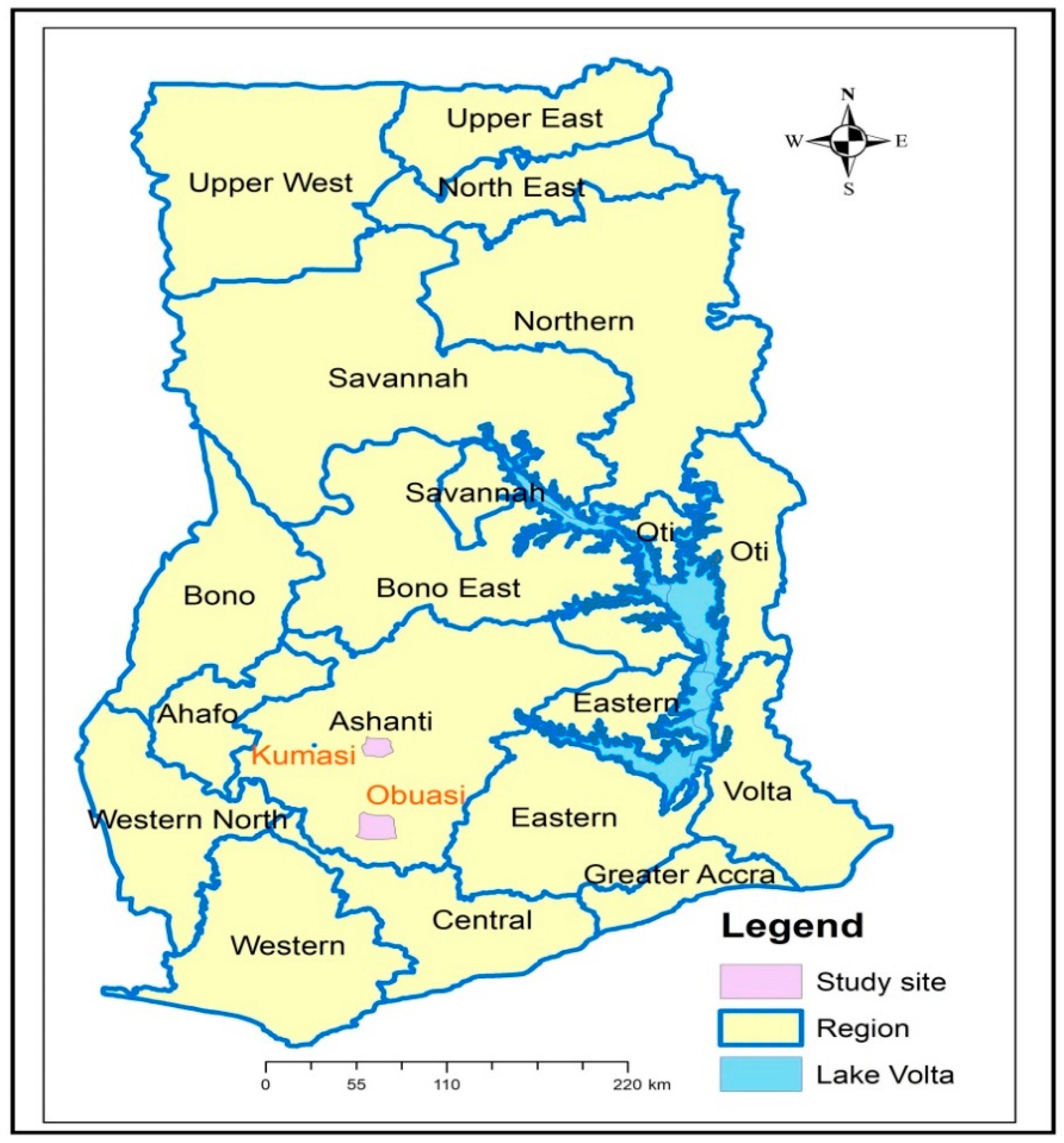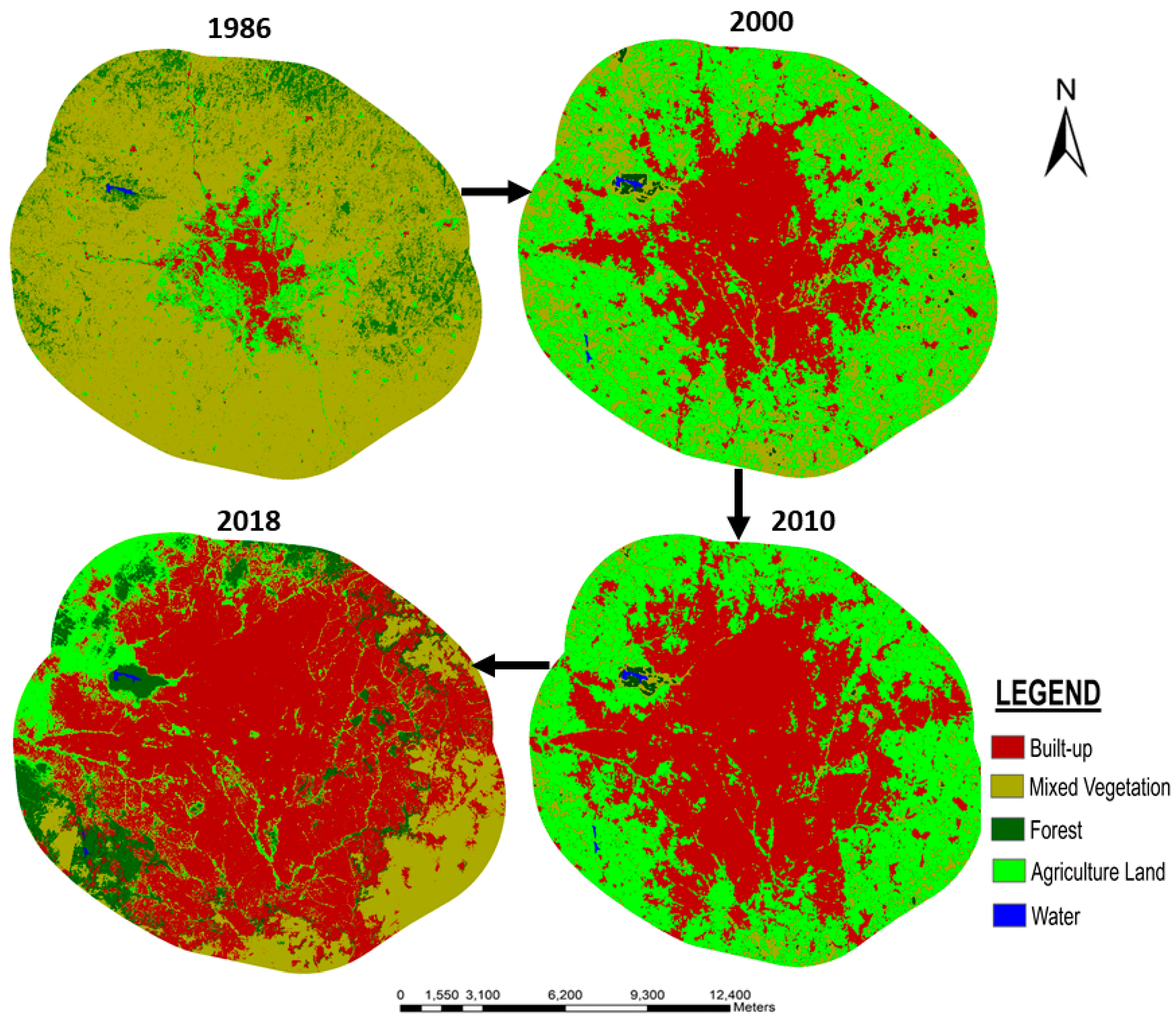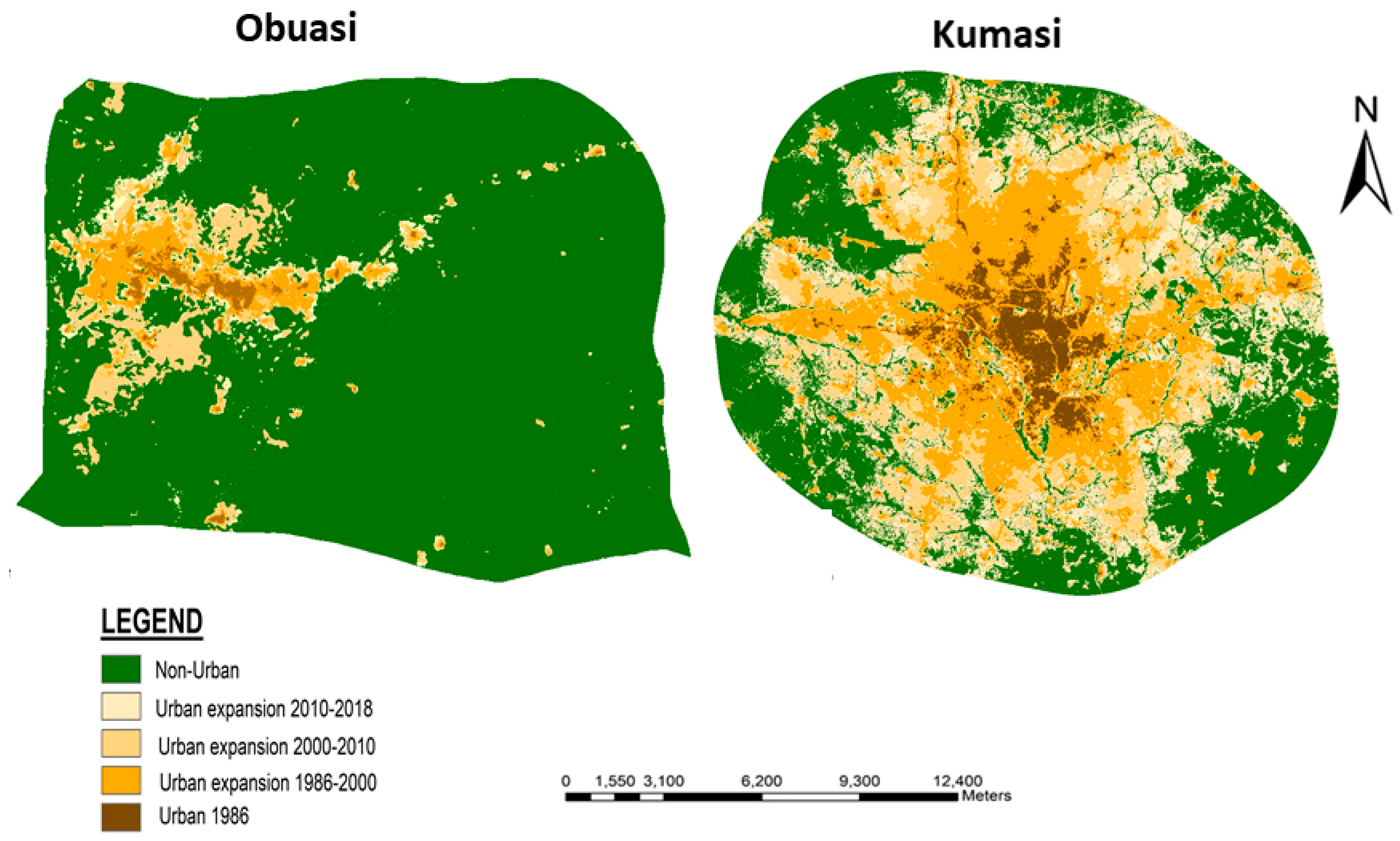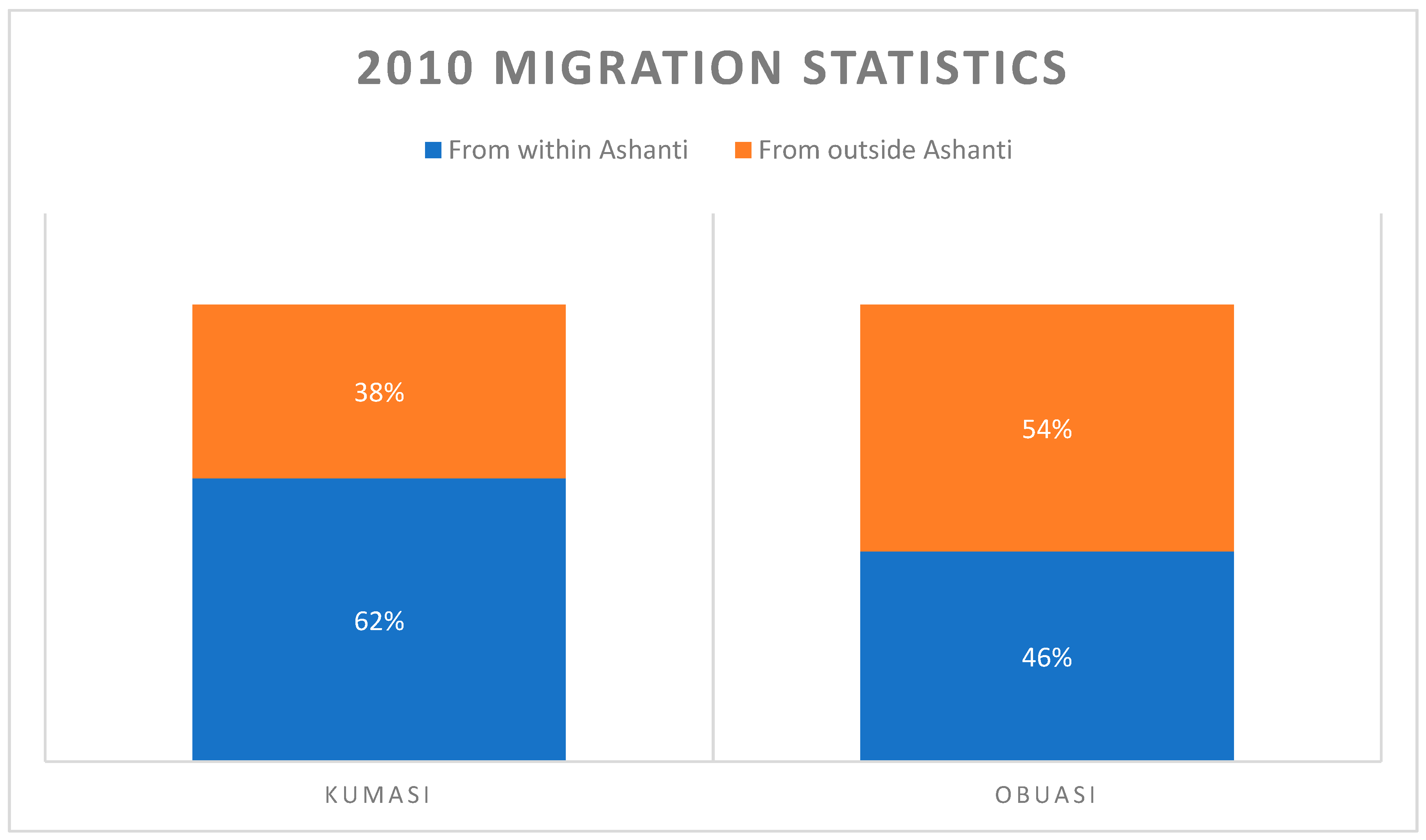Highlighting the Sustainability Implications of Urbanisation: A Comparative Analysis of Two Urban Areas in Ghana
Abstract
:1. Introduction
2. Literature Review
2.1. Urbanisation and SD (Sustainability) in the Context of Land Cover Change (LCC)
2.2. Urbanisation in Ghana
3. Review on Key Concepts or Processes that Potentially Mediate the Sustainability Outcomes of Urbanisation in the Ghanaian Context
3.1. Land Tenure
3.2. Globalisation and Neoliberalism
“the political precept of neoliberalism is that, while all essential collective decisions need to include the constitutional State, State intervention in the social and economic life should generally be minimal. Rather, the role of the State should be primarily to guarantee and ensure freedom of individual economic agents”.
3.3. Poverty, Employment, and Informality
4. Materials and Methods
4.1. Description of Case Study Sites
4.1.1. Kumasi
4.1.2. Obuasi
4.2. Landscape Urbanisation Analysis
4.2.1. Data Acquisition and Image Pre-Processing
4.2.2. Image Classification and Accuracy Assessment
4.2.3. Change Analysis
4.3. Secondary Data Analysis
5. Results
5.1. LCC Characterisation
5.2. Urban Expansion in Kumasi and Obuasi
5.3. Demographic Change in Kumasi and Obuasi
5.4. Population Density in Kumasi and Obuasi
6. Discussion
6.1. Patterns of Urbanisation in Kumasi and Obuasi
6.2. Factors Shaping the Dynamics of Urbanisation in Kumasi and Obuasi
6.3. Sustainability Implications of Urbanisation in Kumasi and Obuasi
6.3.1. Economic Dimension
6.3.2. Social Dimension
6.3.3. Environmental Dimension
7. Recommendation and Limitations
8. Conclusions
Supplementary Materials
Author Contributions
Funding
Acknowledgments
Conflicts of Interest
References
- Dodman, D.; Brown, D.; Francis, K.; Johnson, C.; Satterthwaite, D. Understanding the Nature and Scale of Urban Risk in Low- and Middle-Income Countries and Its Implications for Humanitarian Preparedness, Planning and Response. Available online: https://pubs.iied.org/pdfs/10624IIED.pdf (accessed on 30 February 2020).
- Jeronen, E. Sustainability and Sustainable Development. Encycl. Corp. Soc. Responsib. 2013, 2370–2378. [Google Scholar] [CrossRef]
- World Urbanization Prospects: The 2014 Revision Highlights; United Nations Department of Economic and Social Affairs, Population Division: New York, NY, USA, 2014; Available online: https://population.un.org/wup/Publications/Files/WUP2014-Report.pdf (accessed on 13 February 2020).
- Allen, A. Sustainable Cities or Sustainable Urbanisation? Perspective. UCL’s Journal of Sustainable Cities (Summer Edition). 2009. Available online: https://www.ucl.ac.uk/sustainable-cities/results/gcsc-reports/allen.pdf (accessed on 20 March 2016).
- Jaeger, J.A.G.; Bertiller, R.; Schwick, C.; Kienast, F. Suitability criteria for measures of urban sprawl. Ecol. Ind. 2010, 10, 397–406. [Google Scholar] [CrossRef]
- Zhou, J.; Shen, L.; Song, Z.; Zhang, X. Selection and modelling sustainable urbanization indicators: A responsibility-based method. Ecol. Ind. 2015, 56, 87–95. [Google Scholar] [CrossRef]
- Gong, P.; Liang, S.; Carlton, E.J.; Jiang, Q.; Wu, J.; Wang, L.; Remais, J.V. Urbanisation and health in China. Lancet 2012, 379, 843–852. [Google Scholar] [CrossRef]
- Turok, I.; McGranahan, G. Urbanization and economic growth: The arguments and evidence for Africa and Asia. Environ. Urban. 2013, 25, 465–482. [Google Scholar] [CrossRef]
- Peter, C.; Swilling, M. Sustainable, Resource Efficient Cities: Making It Happen! United Nations Environment Programme: Paris, France, 2012. [Google Scholar]
- Smit, W.; Parnell, S. Urban sustainability and human health: An African perspective. Curr. Opin. Environ. Sustain. 2012, 4, 443–450. [Google Scholar] [CrossRef]
- Cobbinah, P.B.; Erdiaw-Kwasie, M.O.; Amoateng, P. Africa’s urbanisation: Implications for sustainable development. Cities 2015, 47, 62–72. [Google Scholar] [CrossRef]
- Bugliarello, G. Urban sustainability: Dilemmas, challenges and paradigms. Technol. Soc. 2006, 28, 19–26. [Google Scholar] [CrossRef]
- Fang, P.; Chen, J.; John, R. Urbanization and environmental change during the economic transition on the Mongolian Plateau: Hohhot and Ulaanbaatar. Environ. Res. 2016, 144 Pt B, 96–112. [Google Scholar]
- Stow, D.A.; Weeks, J.R.; Shih, H.-C.; Coulter, L.L.; Johnson, H.; Tsai, Y.-H.; Kerr, A.; Benza, M.; Mensah, F. Inter-regional pattern of urbanization in southern Ghana in the first decade of the new millennium. Appl. Geogr. 2016, 71, 32–43. [Google Scholar] [CrossRef] [Green Version]
- Acheampong, R.A.; Agyemang, F.S.; Abdul-Fatawu, M. Quantifying the spatio- temporal patterns of settlement growth in a metropolitan region of Ghana. GeoJournal 2017, 82, 823–840. [Google Scholar] [CrossRef] [Green Version]
- Korah, P.I. Exploring the emergence and governance of new cities in Accra, Ghana. Cities 2020, 99, 102639. [Google Scholar] [CrossRef]
- Toure, S.I.; Stow, D.A.; Clarke, K.; Weeks, J. Patterns of land cover and land use change within the two major metropolitan areas of Ghana. Geocarto Int. 2018, 35, 209–223. [Google Scholar] [CrossRef]
- Gough, K.V.; Yankson, P.W.K. Exploring the connections: Mining and urbanisation in Ghana. J. Contem. Afr. Stud. 2012, 30, 651–668. [Google Scholar] [CrossRef]
- Gough, K.V.; Yankson, P.W.K.; Esson, J. Migration, housing and attachment in urban gold mining settlements. Urban Stud. 2019, 56, 2670–2687. [Google Scholar] [CrossRef]
- Adu, G. Impacts of Foreign Direct Investment (FDI) on Rural Poverty in Developing Countries: The Case of Mining FDI in Ghana. Major Papers 19. Available online: https://scholar.uwindsor.ca/major-papers/19/ (accessed on 2 April 2020).
- Guérin-Pace, F. Rank-size distribution and the process of urban growth. Urban Stud. 1995, 32, 551–562. [Google Scholar] [CrossRef]
- Carlucci, M.; Grigoriadis, E.; Rontos, K.; Salvati, L. Revisiting an Hegemonic Concept: Long-term ‘Mediterranean Urbanization’ in between city re-polarization and metropolitan decline. Appl. Spat. Anal. Policy 2017, 10, 347–362. [Google Scholar] [CrossRef]
- Glaeser, E.L.; Shapiro, J.M. Urban growth in the 1990s: Is city living back? J. Reg. Sci. 2003, 43, 139–165. [Google Scholar] [CrossRef]
- Jones, G.W. Southeast Asian urbanization and the growth of mega-urban regions. J. Popul. Res. 2002, 19, 119–136. [Google Scholar] [CrossRef]
- Martinez-Fernandez, C.; Audirac, I.; Fol, S.; Cunningham-Sabot, E. Shrinking cities: Urban challenges of globalization. Int. J. Urban Reg. Res. 2012, 36, 213–225. [Google Scholar] [CrossRef]
- Report of the World Commission on Environment and Development [WCED]: Our Common Future; Oxford University Press: London, UK, 1987.
- Sakalauskas, L. Sustainability models and indicators. Technol. Econ. Dev. Econ. 2010, 16, 567–577. [Google Scholar] [CrossRef]
- Ward, D.; Phinn, S.R.; Murray, A.T. Monitoring growth in rapidly urbanizing areas using remotely sensed data. Prof. Geogr. 2000, 52, 371–386. [Google Scholar] [CrossRef]
- Serra, P.; Pons, X.; Saurì, D. Land-cover and land-use change in a Mediterranean landscape: A spatial analysis of driving forces integrating biophysical and human factors. Appl. Geog. 2008, 28, 189–209. [Google Scholar] [CrossRef]
- Geri, F.; Amici, V.; Rocchini, D. Human activity impact on the heterogeneity of a Mediterranean landscape. App.Geog. 2010, 30, 370–379. [Google Scholar] [CrossRef]
- Samal, D.; Gedam, S. Monitoring land use changes associated with urbanization: An object-based image analysis approach. Eur. J. R. Sens. 2015, 48, 85–99. [Google Scholar] [CrossRef]
- Lambin, E.F.; Turner, B.I.; Geist, H.J. The causes of land use and land cover change: Moving beyond the myths. Glob. Environ. Chang. 2001, 11, 261–269. [Google Scholar] [CrossRef]
- Turner, B.L.; Lambin, E.F.; Reenberg, A. The emergence of land change science for global environmental change and sustainability. Proc. Natl. Acad. Sci. USA 2007, 104, 20666–20671. [Google Scholar] [CrossRef] [Green Version]
- Wang, X.; Shi, R.; Zhou, Y. Dynamics of urban sprawl and sustainable development in China. Socio-Econ. Plan. Sci. 2020, 70, 100736. [Google Scholar] [CrossRef]
- Zeng, H.; Sui, D.Z.; Li, S. Linking Urban Field Theory with GIS and Remote Sensing to Detect Signatures of Rapid Urbanization on the Landscape: Toward a New Approach for Characterizing Urban Sprawl. Urban Geogr. 2005, 26, 410–434. [Google Scholar] [CrossRef]
- Aurand, A.G. Is Smart Growth for Low-Income House-holds: A Study of the Impact of Four Smart Growth Principles on the Supply of Affordable Housing. Ph.D. Thesis, University of Pittsburgh, Pittsburgh, PA, USA, 2007; 451p. [Google Scholar]
- Abudu, D.; Echina, R.Z.; Andogah, G. Spatial assessment of urban sprawl in Arua Municipality, Uganda. Egypt. J. Remote Sens. Space Sci. 2019, 22, 315–322. [Google Scholar] [CrossRef]
- Jenks, M.; Dempsey, N. The language and meaning of density. In Future Forms and Design for Sustainable Cities; Jenks, M., Dempsey, N., Eds.; Architectural Press: Oxford, UK, 2005. [Google Scholar]
- Polidoro, M.; Lollo, D.A.L.; Barros, F.V.M. Urban sprawl and the challenges for urban planning. J. Environ. Prot. 2012, 3, 1010–1019. [Google Scholar] [CrossRef] [Green Version]
- Yeboah, E.; Obeng-Odoom, F. We are not the only ones to blame’: District Assemblies’ perspectives on the state of planning in Ghana. Commonw. J. Local Gov. 2010, 7, 78–98. [Google Scholar] [CrossRef] [Green Version]
- Coulter, L.L.; Stow, D.A.; Tsai, Y.; Ibanez, N.; Shih, H.; Kerr, A.; Benza, M.; Weeks, J.R.; Mensah, F. Classification and assessment of land cover and land use change in southern Ghana using dense stacks of Landsat 7 ETM+ imagery. Remote Sens. Environ. 2016, 184, 396–409. [Google Scholar] [CrossRef]
- Attua, E.M.; Fisher, J.B. Historical and Future Land-Cover Change in a Municipality of Ghana. Earth Interact. 2011, 15, 1–26. [Google Scholar] [CrossRef] [Green Version]
- Owusu, G.; Afutu-Kotey, R.L. Poor urban communities and municipal interface in Ghana: A case study of Accra and Sekondi-Takoradi metropolis. Afr. Stud. Q. 2010, 12, 1. [Google Scholar]
- Abulibdeh, A.; Al-Awadhi, T.; Al-Barwani, M. Comparative analysis of the driving forces and spatiotemporal patterns of urbanisation in Muscat, Doha, and Dubai. Dev. Pract. 2019, 29, 606–618. [Google Scholar] [CrossRef]
- Aryee, B.N.A.; Ntibery, B.K.; Atorkui, E. Trends in the small-scale mining of precious minerals in Ghana: A perspective on its environmental impact. J. Clean. Prod. 2003, 11, 131–140. [Google Scholar] [CrossRef]
- Bloch, R.; Owusu, G. Linkages in Ghana’s gold mining industry: Challenging the enclave thesis. Resour. Policy 2012, 37, 434–442. [Google Scholar] [CrossRef]
- Hilson, G. Corporate social responsibility in the extractive industries: Experiences from developing countries. Resour. Policy 2012, 37, 131–137. [Google Scholar] [CrossRef]
- Standing, A. Ghana’s extractive industries and community benefit sharing: The case for cash transfers. Resour. Policy 2014, 40, 74–82. [Google Scholar] [CrossRef]
- Jabareen, Y. A new conceptual framework for sustainable Development. Environ. Dev. Sustain. 2008, 10, 179–192. [Google Scholar] [CrossRef]
- Owoo, N.S.; Boakye-Yiadom, L. The gender dimension of land tenure security on agricultural productivity: Some evidence from two districts in Kenya. J. Int. Dev. 2015, 27, 917–928. [Google Scholar] [CrossRef]
- Lemmen, C. The Social Tenure Domain Model: A Pro-Poor Land Tool; The International Federation of Surveyors: Copenhagen, Denmark, 2010. [Google Scholar]
- Aubynn, A.K. Live and let live’: The relationship between artisanal/small-scale and large-scale miners at Abosso Goldfield, Ghana. In Small-Scale Mining, Rural Subsistence and Poverty in West Africa; Hilson, G.M., Ed.; Practical Action Publishing: Rugby, UK, 2006; pp. 237–240. [Google Scholar]
- Nyame, F.K.; Blocher, J. Influence of land tenure practices on artisanal mining activity in Ghana. Resour. Policy 2010, 35, 47–53. [Google Scholar] [CrossRef]
- Siiba, A.; Adams, E.A.; Cobbinah, P.B. Chieftaincy and sustainable urban land use planning in Yendi, Ghana: Towards congruence. Cities 2018, 73, 96–105. [Google Scholar] [CrossRef]
- Boamah, N.A.; Gyimah, C.; Nelson, J.K.B. Challenges to the enforcement of development controls in Wa municipality. Habitat Int. 2012, 36, 136–142. [Google Scholar] [CrossRef]
- Ahmed, A.; Dinye, R.D. The impact of land use activities on Subin and Aboabo Rivers in Kumasi Metropolis. Int. J. Water Res. Env. Eng. 2012, 4, 241–251. [Google Scholar]
- Jnr, S.D.; Cieem, G.; Ayensu-Ntim, A.; Twumasi-Ankrah, B.; Barimah, P.T. Effects of Loss of Agricultural Land Due to Large-Scale Gold Mining on Agriculture in Ghana: The Case of the Western Region. Br. J. Res. 2016, 2, 196–221. [Google Scholar]
- Janz, N. Foreign direct investment and repression: An analysis across industry sectors. J. Hum. Rights 2018, 17, 163–183. [Google Scholar] [CrossRef]
- Obeng-Odoom, F. Neoliberalism and the Urban Economy in Ghana: Urban Employment, Inequality, and Poverty. Growth Chang. 2012, 43, 85–109. [Google Scholar] [CrossRef]
- Addison, T.; Heshmati, A. The New Global Determinants of FDI Flows to Developing Countries: The Importance of ICT and Democratization (Working Paper No. 2003/45). WIDER Discussion Papers//World Institute for Development Economics (UNU-WIDER). Available online: https://www.econstor.eu/handle/10419/52914 (accessed on 2 April 2020).
- Andrews, N. Challenges of corporate social responsibility (CSR) in domestic settings: An exploration of mining regulation vis-à-vis CSR in Ghana. Resour. Policy 2016, 47, 9–17. [Google Scholar] [CrossRef]
- Amponsah-Tawiah, K.; Darteh-Baah, K. The mining industry in Ghana; a Blessing or a curse? Int. J. Bus. Soc. Sci. 2011, 2, 62–69. [Google Scholar]
- Harvey, D. From Managerialism to Entrepreneurialism: The Transformation in Urban Governance in Late Capitalism. Geogr. Ann. 1989, 71, 3–17. [Google Scholar] [CrossRef]
- OECD. Competitive Cities: A New Entrepreneurial Paradigm in Spatial Development. Available online: https://www.oecd.org/cfe/regional-policy/38747575.pdf (accessed on 3 January 2019).
- Lauermann, J. Urban Managerialism/Entrepreneurialism. In The Wiley-Blackwell Encyclopedia of Social Theory; Wiley: Hoboken, NJ, USA, 2017. [Google Scholar] [CrossRef]
- Wang, X.; Tomaney, J. Zhengzhou—Political economy of an emerging Chinese megacity. Cities 2019, 84, 104–111. [Google Scholar] [CrossRef]
- Mishra, R. Globalization and the Welfare State; Edward Elgar: Cheltenham, UK, 1999. [Google Scholar]
- World Bank. Rising Through Cities in Ghana: Urbanization Review-Overview Report; World Bank Group: Washington, DC, USA, 2015. [Google Scholar]
- UNICEF. Understanding the specifics of urban poverty: A case study from Accra, Ghana. In The State of the World’s Children 2012; UNICEF: New York, NY, USA, 2012. [Google Scholar]
- Ofori, E.G. Taxation of the Informal Sector in Ghana: A Critical Examination. Master’s Thesis, Institute of Distance Learning, KNUST, Kumasi, Ghana, May 2009. [Google Scholar]
- Osei-Boateng, C.; Ampratwum, E. The Informal Sector in Ghana. Available online: https://library.fes.de/pdf-files/bueros/ghana/10496.pdf (accessed on 29 July 2019).
- World Bank Report. World Development Report: Attacking Poverty; Oxford University Press: New York, NY, USA, 2000. [Google Scholar]
- Potts, D. Debates about African urbanisation, migration and economic growth. Geogr. J. 2016, 182, 251–264. [Google Scholar] [CrossRef] [Green Version]
- Porter, L. Informality, the commons and paradoxes for planning: Concepts and debates for informality and planning. Plann. Theor. Pract. 2011, 12, 112–120. [Google Scholar]
- Hormeku, T. The Transformation and Development of the Informal Sector and the Role of Trade Unions. In Proceedings of the OATUU/ILO/ETUF Seminar on “Trade Unions and the Informal Sector”, Cairo, Egypt, 4–6 May 1998. [Google Scholar]
- Agyei-Mensah, S.; Owusu, G. Segregated by neighbourhoods? A portrait of ethnic diversity in the neighbourhoods of the Accra Metropolitan Area, Ghana. Popul. Space Place 2010, 16, 499–516. [Google Scholar] [CrossRef]
- Owusu, G.; Agyei-Mensah, S. A comparative study of ethnic residential segregation in Ghana’s two larget cities, Accra and Kumasi. Popul. Environ. 2011, 32, 332–352. [Google Scholar] [CrossRef]
- Landsat Levels of Processing. Available online: https://www.usgs.gov/land-resources/nli/landsat/landsat-levels-processing (accessed on 25 September 2019).
- Anderson, J.R.; Hardy, E.E.; Roach, J.T.; Witmer, W.E. A Land Use and Land Cover Classification System for Use with Earth Observation Data; USGS Professional Paper 964; USGS: Reston, Virginia, 1976.
- Ghana Statistical Service. 2010 Population and Housing Report: Urbanisation. Available online: http://www.statsghana.gov.gh/gssmain/fileUpload/pressrelease/Urbanisation%20in%20Ghana.pdf (accessed on 10 January 2017).
- Ghana Statistical Service. District Analytical Report: Kumasi Metropolitan. Available online: http://www2.statsghana.gov.gh/docfiles/2010_District_Report/Ashanti/KMA.pdf (accessed on 10 January 2017).
- Ghana Statistical Service. District Analytical Report: Obuasi Municipality. Available online: http://www2.statsghana.gov.gh/docfiles/2010_District_Report/Ashanti/OBUASI.pdf (accessed on 10 January 2017).
- Ghana Statistical Service. Population Projections. Available online: http://www.statsghana.gov.gh/nationalaccount_macros.php?Stats=MTA1NTY1NjgxLjUwNg==/webstats/s679n2sn87 (accessed on 13 March 2019).






| LCC Classes | Area Coverage (km2) | Changes in Area (%) | ||||||
|---|---|---|---|---|---|---|---|---|
| 1986 | 2000 | 2010 | 2018 | 1986–2000 | 2000–2010 | 2010–2018 | 1986–2018 | |
| Built-Up | 43.23 | 232.92 | 390.23 | 509.20 | 438.79 | 67.53 | 30.50 | 1105.77 |
| Agriculture Land | 64.75 | 400.71 | 373.96 | 118.55 | 518.85 | −6.68 | −68.30 | 83.00 |
| Mixed Woody Vegetation | 628.76 | 176.34 | 46.57 | 113.35 | −71.95 | −73.59 | 143.39 | −81.97 |
| Water | 0.50 | 0.96 | 0.96 | 0.67 | 92.00 | 0.00 | −30.20 | 34.00 |
| Forest | 78.11 | 4.42 | 3.63 | 73.58 | −94.34 | −17.87 | 1924.51 | −5.91 |
| Total | 815.35 | 815.35 | 815.35 | 815.35 | ||||
| LULC Classes | Area Coverage (km2) | Changes in Area (%) | ||||||
|---|---|---|---|---|---|---|---|---|
| 1986 | 2000 | 2010 | 2018 | 1986–2000 | 2000–2010 | 2010–2018 | 1986–2018 | |
| Built-Up | 23.60 | 36.62 | 46.50 | 57.68 | 55.16 | 27 | 24 | 144.40 |
| Agriculture Land | 126.64 | 80.13 | 110.03 | 126.83 | −36.72 | 37.31 | 15.27 | 0.15 |
| Mixed Woody Vegetation | 161.56 | 189.41 | 76.06 | 117.52 | 17.31 | −59.84 | 54.51 | −27.26 |
| Forest | 58.16 | 70.08 | 119.04 | 71.55 | 20.49 | 69.86 | −39.89 | 23.02 |
| Water | - | 0.07 | 1.20 | 0.07 | - | 1614 | 94.17 | - |
| Bare ground | - | - | 11.15 | - | - | - | - | - |
| Mining | 10.55 | 4.20 | 16.53 | 6.86 | −60.19 | 293.57 | −58.5 | −34.98 |
| Total | 380.51 | 380.51 | 380.51 | 380.51 | ||||
| Location | Population | Average Annual Change in Population (%) | |||||
|---|---|---|---|---|---|---|---|
| 1984 | 2000 | 2010 | 2019 | 1984–2000 | 2000–2010 | 2010–2019 | |
| Kumasi | 496,628 | 1,170,270 | 1,730,249 | 2,105,382 | 14.81 | 4.79 | 2.41 |
| Obuasi | 60,617 | 115,564 | 143,644 | 203,554 | 11.94 | 2.43 | 4.63 |
| Kumasi | Obuasi | |||||
|---|---|---|---|---|---|---|
| Year | Built-Up Area | Population | Pop. Density (Mean) | Built-Up Area | Population | Pop. Density (Mean) |
| 1984/1986 | 43.22 | 496,628 | 11,491 | 23.60 | 60,617 | 2569 |
| 2000 | 232.92 | 1,170,270 | 5024 | 36.60 | 115,564 | 3156 |
| 2010 | 390.23 | 1,730,249 | 4434 | 46.50 | 143,644 | 3089 |
| 2018/2019 | 509.20 | 2,105,382 | 4135 | 57.68 | 203,554 | 3529 |
© 2020 by the authors. Licensee MDPI, Basel, Switzerland. This article is an open access article distributed under the terms and conditions of the Creative Commons Attribution (CC BY) license (http://creativecommons.org/licenses/by/4.0/).
Share and Cite
Anarfi, K.; Hill, R.A.; Shiel, C. Highlighting the Sustainability Implications of Urbanisation: A Comparative Analysis of Two Urban Areas in Ghana. Land 2020, 9, 300. https://doi.org/10.3390/land9090300
Anarfi K, Hill RA, Shiel C. Highlighting the Sustainability Implications of Urbanisation: A Comparative Analysis of Two Urban Areas in Ghana. Land. 2020; 9(9):300. https://doi.org/10.3390/land9090300
Chicago/Turabian StyleAnarfi, Kwasi, Ross A. Hill, and Chris Shiel. 2020. "Highlighting the Sustainability Implications of Urbanisation: A Comparative Analysis of Two Urban Areas in Ghana" Land 9, no. 9: 300. https://doi.org/10.3390/land9090300
APA StyleAnarfi, K., Hill, R. A., & Shiel, C. (2020). Highlighting the Sustainability Implications of Urbanisation: A Comparative Analysis of Two Urban Areas in Ghana. Land, 9(9), 300. https://doi.org/10.3390/land9090300






